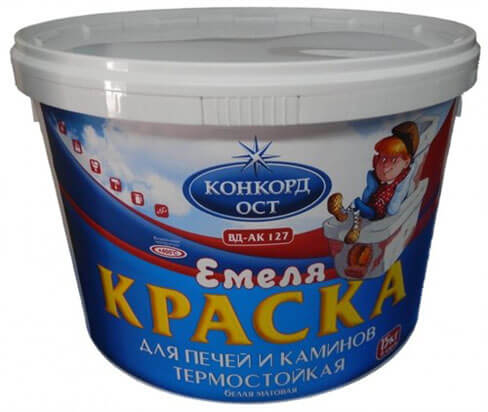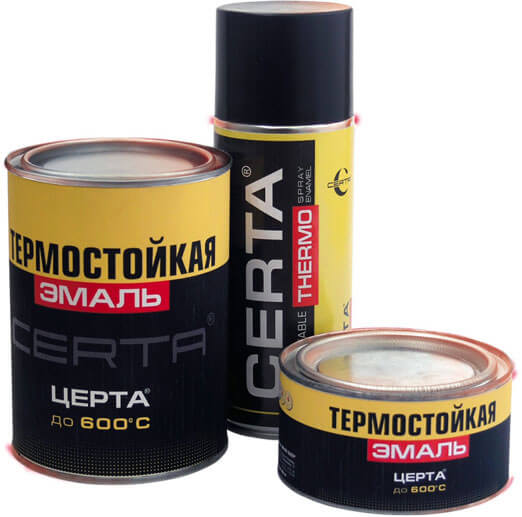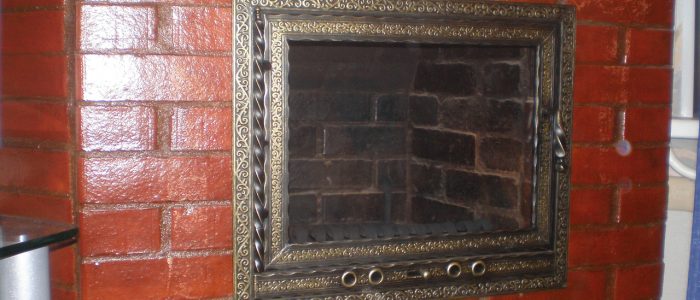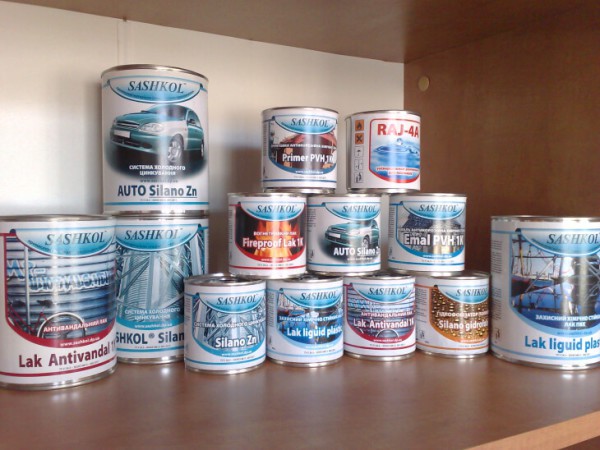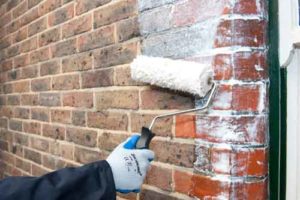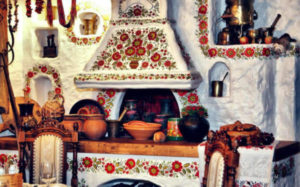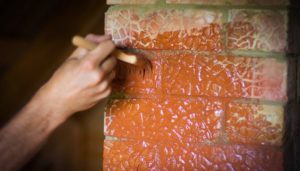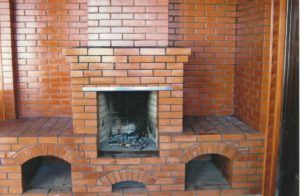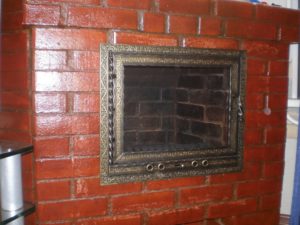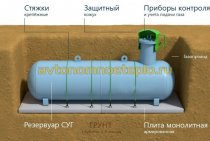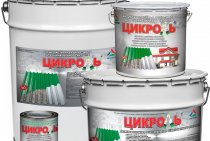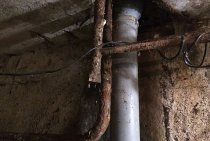Paint application
Painting fireplaces requires preparation, just like any other construction work. First you need to make sure that you bought exactly the composition that you need.
You also need to prepare the following tools:
- soft cloth;
- sandpaper;
- water;
- tassel;
- roller;
- copper sulphate solution;
- sulfuric acid solution;
- spray.
First, the surface to be painted is prepared. It is cleaned of dust and dirt. Metal parts are cleaned with fine sandpaper. Grease stains must be removed with a soft cloth moistened with a solution of water and salt. Soot is easily removed with a solution of hydrochloric acid, and rust is easily removed with a 10% mixture of copper sulphate.
It is recommended to apply the paint on a slightly warm surface with a brush, roller or sprayer - whichever is more convenient. In total, you need to make 2-3 layers, each of them must be allowed to dry well before applying the next. Within a few days, the hearth should dry, until the paint has completely hardened, it cannot be used.
Choose the type of painting
Painting with chalk or lime - the base of a brick (stove or fireplace) can be painted with limestone whitewash with your own hands. When mixing the composition (100 grams of lime, 40 grams of salt diluted in water), it should resemble liquid sour cream. Before painting, the surface of the fireplace must be prepared, cleaned of dirt and dust with a scraper or spatula. Irregularities should be filled with putty (brick flour and latex paint).
Also, the stove or fireplace in the house can be painted with chalk. it should be sifted and diluted with low-fat (preferably skim) milk, in order to remove the yellowness, you can add blue. Before painting, the base is moistened with water. The painting process is long, you need to paint in 2-3 layers. Layers are superimposed only when the previous one is completely dry.
If in the question “How to paint the oven? » you tend to more modern methods, then when choosing a paint, the main emphasis should be on its heat resistance.
Painting with oil or enamel paints will enhance heat transfer, it is better to choose a dark color, such a surface gives off more heat. You should not choose glossy or smooth surfaces, they can significantly reduce efficiency.
Water-based paint is a common option, applicable to brick and concrete surfaces, plaster or drywall. Dries quickly, safe, easy to apply with a brush or roller, easy to choose the right shade. The disadvantages of this one are the speed of absorption and its price is higher than other means of ennobling the furnace.
If the furnace is made according to the required standards, then the heating of the surface can reach 80 degrees. For such temperatures, synthetic-based paints are suitable - nitro paints, pentaphthalic. If drying oil is included in the base of the paint, then it may darken at a temperature.
Heat resistant paints. sold in stores, have good heat dissipation, but their palette is not large. If the colors presented do not fit, then you can paint the brick oven with latex paint after preliminary priming.
Silicone-organic enamel is heat-resistant, durable, such paint must be applied in a thin even layer, for optimal color in 2-3 layers.
Surface preparation
First of all, it is necessary to attend to the preparation of the furnace surface. Before starting work, it is recommended to inspect the stove or fireplace. New brickwork does not require any special preparation, except for cleaning it from dust. If the stove was plastered earlier, then you need to find out how thick the layer is. With a thickness of more than 1 cm, heat transfer decreases sharply. Such plaster must be dismantled. When it is not about complete removal, only crumbling areas are scraped off. The entire surface of the stove is thoroughly cleaned.Cracks and sanded areas are rubbed with lime-gypsum or lime-clay composition.
It is not always necessary to remove the old paint. If it is not badly damaged, then it is enough to wipe off the dirt and dust. Then you can cover with a fresh layer. But first you need to find out what kind of coating was applied. The newly applied layer must match the old one. For example, chalk paint will not adhere to lime whitewash, it will simply crumble. And vice versa. If you don’t know for sure, then it’s better to scrape everything down to the brick. Before painting the stove, dust must be removed with a damp cloth. Then let the surface dry thoroughly.
There are no special tricks in how to paint a brick oven. This can be done by any unprepared person. Diluted or ready-made paints are simply applied with a brush in two or more layers. The painting of the plastered oven is carried out only after the preparatory work has been completed, otherwise it will be ineffective. And it will have to be repeated after a very short period of time.

- painting;
- plaster;
- varnish coating;
- laying with heat-resistant ceramic tiles or tiles.
Now let's take a closer look at how to paint a brick stove. Not every paint is suitable for this. It must meet certain specifications. Good heat-resistant paint protects brickwork from aggressive environments and moisture. Here are some of the more common staining methods for bricks:
- whitewashing with lime;
- chalk coloring;
- coating with homemade paint;
- painting with modern materials.
Painting with hand-made materials
Brick processing can also be done with paints prepared by one's own hands.
Consider the option of homemade brick paint. The brick is ground into small crumbs, sifted through a sieve so that the mass is absolutely homogeneous. It is then mixed with country milk and egg whites. With a wide brush, a solution is applied to a warm oven, which should resemble liquid sour cream. If necessary, it is covered with drying oil or varnish on top (if a shiny surface is needed). A heat-resistant, abrasion-resistant coating of natural brick color is formed. This is a good country option, when naturalness prevails in the interior.
Painted brick will be slightly dirty. To eliminate this disadvantage, it is recommended to apply a layer of beaten egg white on a well-heated oven. Such heat-resistant paint will well protect the brickwork from moisture and dirt. This method has been used since ancient times. Such a coating is called oven varnish. You can not add brick chips to it, then it will be completely transparent. When the oven is used in the room, there will be a slight smell of baked milk. This must be taken into account.
There is also a very economical option for making homemade paint. Turpentine and PF varnish are mixed in equal proportions. It is tinted with dry dyes, you can even use dried gouache.
Features of heat-resistant paint for stoves and fireplaces
The furnace is a construction made of bricks and stones, to which elements of cast iron are added (doors, barriers, frames, covers and other elements). If desired, you can paint the entire hearth, but the choice of paint must be approached responsibly. For example, many of them indicate which materials they are suitable for. But this must be checked by specifying the composition and properties of the paint. Surely it will not be possible to get by with just one can, since the materials used in laying the furnace have a different structure, which means that the requirements for the coloring composition will be different.
If the hearth is located outside, then it is necessary to use paint with high anti-corrosion properties - this will prevent the appearance of rust due to moisture. However, it must be borne in mind that concrete and metal products contain different components. You can also use a universal thermal paint, which can be applied to various materials. It forms a thin film on their surface that protects against moisture, air and other factors that lead to rust.
Advantages of the mineralite plate
1. Fire resistance
The bath is a fire hazardous building. In any bath, a stove is installed, and in some there is also a heater. They heat the room to the desired temperature and emit hot heat. Therefore, the issue of safety and security of the building should be in the first place. To date, there are many special materials that can protect the building from fire. One of them is the minerite slab. Having made the wall fencing off the heating stoves and heaters with such fiber cement panels, you can be calm about the fire hazard. They will serve well and with dignity, as they absolutely do not burn or ignite. This fire resistance meets the most stringent fire safety requirements. Minerite is a completely non-combustible building board with an excellent degree of fire resistance, so products are often used to protect flammable elements.
2. Eco-friendly
The difference between the mineralite plate and other building materials lies in the absence of any substances hazardous to health in its composition and the ability to self-clean. Thanks to environmentally friendly technologies, tiles do not emit harmful fumes when heated. As a result, such a heater can be confidently used to create thermal insulation for baths, saunas, steam rooms. Thanks to this material, it will be possible to create an absolutely reliable and harmless indoor microclimate.
3. Resist mold and rot
The main component of tiles is cement, which creates an alkaline environment. Therefore, the formation of mold, fungi and other microorganisms is absolutely excluded.
Moisture-resistant plywood does not rot or decompose, which is very important when used in rooms such as a bath or sauna
4. Strength, wear resistance and durability
The mineralite plate differs from many similar special materials in its increased impact resistance. Such a panel with an impact-resistant surface is practically not deformed and can withstand heavy physical exertion. Decent strength qualities of the minerite plate affect the operation, during which there is an almost complete absence of deformations.
5. Ease of installation
Minerite slabs stand out for their specificity and ability to be used in places where it is very difficult or even impossible to use other building materials. During construction, panels can be installed at any time of the year. Installation is quick and easy, so you can do it yourself.
6. Soundproofing
This building material has excellent soundproofing properties. Minerite are tiles with a very small thickness, which is about four to twelve millimeters. But thanks to such an insignificant thickness, it turns out that it is possible to significantly reduce the level of noise in the room. In this regard, this heat insulator is also considered an excellent sound insulator. 7. Versatility
Minerite is considered a universal material. It can be used not only for insulation, but also for decorative finishes.
8. Frost resistance
9. Resistance to acids, alkalis, oils and salts.
Minerite slabs do not have significant drawbacks, except that they are not too presentable in appearance.However, today there is a decorative minerite that looks much more aesthetically pleasing than ordinary gray. Perhaps he should give his preference, finishing the inside of the bathhouse, even if it will cost a little more.
Applying paint to metal surfaces
First, the metal elements are cleaned with sandpaper, and the walls of the fireplace are cleaned of dust with a damp cloth. Metal shutters are treated with a 5% sulfuric acid solution and a lint brush. It is necessary to work with acid with gloves. The remains of the composition are washed off with soapy water - first with a cloth, and then with a rag.
If the hearth is not built too correctly (for example, the masonry is uneven), then the surface must be plastered with lime-gypsum mortar in several layers, after heating the oven to 150 degrees.
When painting, it is important to remember the safety rules: work with gloves and only in a well-ventilated area. It is also necessary to avoid getting paint and other products on the skin or in the eyes.
An important stage of decorative cladding is painting a brick fireplace. Even if a special facing material is chosen during construction, which does not require subsequent puttying for durability and a beautiful appearance, it is important to choose the right coating
Properly selected paint or varnish will keep the bricks from destruction and add aesthetic appearance.
Instructions for painting a brick fireplace
Necessary tools and materials: nsandpaper, vacuum cleaner, construction cloth, construction tape, brick primer, brush and roller, paint tray, latex paint.
Choice of colors for the fireplace
Choose the color you would like to paint the fireplace, the decorative fence of the hearth is painted in the main color. If you're overwhelmed by the wide range of different colors, it's worth getting inspired and getting creative. You can choose from the existing colors of the room, such as fabric, curtains, upholstery or pillows, or any other color you like.
Preparation of the working surface - brickwork
The next step is to prepare the work surface, and for this you will need to prepare and clean the brick. Use sandpaper to sand the surface of your brick fireplace. This solution will help you remove the pieces of mortar, after which you need to use a vacuum cleaner to get rid of dust and dirt. Use a bucket of soap and water to clean any stains and grease from the surface of the brick, then let your fireplace's brickwork dry. Repeat with the vacuum cleaner.
Foreign surface protection
Continue with prep work, which involves covering with construction tape and construction fabric any areas and objects that you do not want to paint
This is a very important decision that will save a lot of time later on, which would otherwise be spent on fixing errors such as accidental paint drops.
Priming work
Find a primer that can be used for masonry building projects. You can use a thick layer of primer (up to one inch) to cover the surface and then use a brush to finish difficult spots. Let the primer dry. If you plan on using bright colors that deviate from the original paint or original brick color, you can use a tinted primer in the intended color to make the new paint work easier.
Painting a brick fireplace
Now you need to proceed to direct staining. Use your chosen paint color. Use only high quality latex paint with which to start painting the brickwork of your fireplace with a roller or brush.For a full and long lasting paint finish, you may want to consider applying two or three coats of paint. The fact is that the porous surface of the brick absorbs paint very effectively, which can result in defects on the masonry surface if you applied only one layer of paint.
Tips and Warnings
Choose inexpensive brushes for painting a brick fireplace. The rough and porous surface of the brick will destroy the bristles of any, even the most expensive brushes. Don't limit yourself to a construction project that is yours alone. You can choose to paint your fireplace a single solid color, or, alternatively, get creative and create a layered look by lightening and blending different colors for added effect. If you're planning to make a brick fireplace stand out as the focal point of the room, consider painting the fireplace a different color from what's on the walls of the room.
On the other hand, if you want to diffuse attention around the fireplace, paint it the same color as the walls.
Why you need to paint
One of the modern fashion trends is the presence in the interior of decorative elements made of natural stone or brick. Many designers use the natural look and texture of the material. It looks especially beautiful when building and facing fireplaces and stoves, combining the rough look of brickwork and a living flame, creating an atmosphere of comfort at home.
A simple red brick for masonry attracts at an affordable price, but its quality often leaves much to be desired, in which case they resort to painting or plastering. If you spend money and purchase a special facing option, it is enough to treat it with a special varnish, which will add richness and expressiveness to the appearance. Reasons to paint a red brick fireplace:
- erosion protection;
- hiding minor defects in masonry and material;
- additional strengthening of the structure;
- aesthetic appearance and rich color.
General recommendations
An experienced craftsman will advise that it is important not only to install a fireplace or stove, adhering to the technology, but also to cover it correctly, then the design will serve for many years and delight with warmth and beautiful appearance. It is advised to adhere to the following principles: Painting the building should be done when it is warm
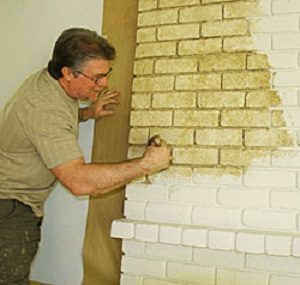
- start painting or cladding a few months after installation (up to a year), waiting for complete drying;
- select a special coating that can withstand high temperatures;
- pre-treat the surface, remove dust, wash and dry;
- apply paint on a warm (non-hot) surface in 2 or even 3 layers.
What paints are used to cover a brick fireplace?
For surface treatment, which is constantly under the influence of high temperature, it is necessary to carefully approach the choice of coating. To preserve the natural look, varnishes are used, and paint is bought in the store to change the color or hide the imperfections of the masonry. Folk dyes for stoves based on lime, clay or chalk have long been known, which save the budget and add a touch of antiquity to the interior.
The owner who wants to cover the brickwork must remember that ordinary oil paint cannot be used, it delaminates when heated, forming fumes and an unpleasant odor that are dangerous to human health. Most manufacturers produce specialty products that are labeled "heat resistant". Such products are intended for professional or independent surface treatment. The maximum allowable temperature is indicated on the packaging of the product.
Grandma's painting methods
- lime;
- chalk solution;
- clay;
- homemade dye.
Chalk mix
To prepare a chalk solution that is safe to paint the fireplace, take loose chalk and fill it with water. Leave for several hours until dissolved. At the same time, glue (carpentry or casein) is prepared with the calculation of 100 grams per bucket of solution. The chalk suspension is stirred to the consistency of sour cream, the adhesive component is added and thoroughly mixed again. Brilliant blue or manganese is used to change the color, and artificial dyes are also allowed, which are applied at high temperatures. Paint with a roller or a stiff brush. The second layer is applied only after the previous one has completely dried.
Lime for painting
Lime mortar is one of the most popular old-fashioned methods of coating not only stoves, but also the walls of the house, it allows you to cheaply process the coating to achieve the desired color and protect against pests. For 1 kg of quicklime take 1.5 liters of water. Colors are achieved by the same methods as in the case of chalk. For application use a wide brush or roller, several layers can be applied one after another without waiting for drying.
other methods
Such folk methods of covering fireplaces or stoves are known:
- Sparse clay solution. It is available, but does not allow experimenting with color, suitable for lovers of natural coverage.
- Home-made paints: mix PF-283 glue with a solvent or turpentine.
Processing steps
It is important to follow the phased work to achieve the expected result. Pre-removed the remnants of the previous coating
Apply the solution on a previously prepared surface, using only products selected for the appropriate temperature. Each next layer is applied after the previous one has dried. You can heat the fireplace 2-3 days after treatment, so that the paint dries evenly, does not exfoliate or fade.
Why paint brick stoves
There are several reasons for painting brick ovens:
- Craving of owners for aesthetics. If earlier a stove in a village house was the only heating device, now fireplaces and stoves serve as interior elements that must be harmoniously integrated into the home.
- Finishing the surface of the stove with paints prevents the appearance and then the increase of cracks in the bricks. makes the surface even.
- After painting, heat transfer to the room increases.
Tip: It should be borne in mind that the mode of operation of the stove in the country or in the house is very different from the stove in the bath. The coating technology will be different: the materials for processing the stove in the bath may not be suitable for the stove in the country at all.
How to paint a brick oven
For painting furnaces, materials such as:
Natural drying oil. The coating does not change the color of the brick, but changes its shade to a darker one. It can be used to cover stoves in the bath.
Tip: When using natural drying oil for a brick oven, after kindling it, you can only use it for a few hours. You should not experiment with drying oil in the house: different combustion modes in the oven can prevent the drying oil from drying out.
Silicone enamels. Its specifications:
- excellent adhesion with all materials;
- high strength;
- moisture resistance;
- durability.
- the ability to withstand up to 200 cycles of change of positive and negative temperatures.
The disadvantage of organosilicon enamels is a small selection of colors.
Varnish PF 283. When using varnish, it is mixed with turpentine in equal proportions, which increases the strength characteristics of the material. After drying, a transparent glossy layer of high quality is formed on the surface of the oven.
The peculiarity of the use of varnish is the ability to add dry gouache, which will allow you to get the paint material of the desired color.
Heat-resistant paints (see Heat-insulating paint: material features). It's almost ideal. Its advantages:
- a huge selection of colors;
- withstand temperatures up to 600ºС;
- protects brickwork from oxidation;
- increased strength and endurance;
- ease of application, without preliminary priming of the surface;
- retains performance up to 10 years.
During the operation of the furnace, efflorescence may appear on the brick. This comes from exposure to high temperatures, when moisture begins to be displaced from the brick along with salt. Heat-resistant paints will not lose their characteristics from this.
the presence of an aggressive chemical composition;
bad smell;
dries for a long time;
care must be taken when working due to the presence of toxic substances in the mixture.
How to paint a brick oven
There is no particular difficulty in painting a brick stove, so anyone can do this, even if he has not done it before.
Painting, especially for a freshly plastered stove, occurs only after all the preparatory points of the work have been observed and completed, otherwise it will not be effective and will have to be reproduced after a short period of time.
For staining you will need the following devices:
- Container for coloring agent;
- The coloring solution itself;
- Convenient brush and roller.
Prepare a coloring solution and apply it in the desired number of layers. It is recommended to apply the paint in two or three thin coats, using both a brush and a roller if possible. The brush will be able to give texture to the outside of the fireplace, and the roller will distribute the paint evenly over the entire surface. If desired, patterns can be applied to the final layer of paint.
Kiln painted with lime mortar
Staining the oven with a special varnish
Furnace painted with natural varnish and drying oil
Enamel oven
How to paint a brick oven
There are several materials that can be stained:
- Enamel. It is characterized by good strength, resistance to moisture, excellent interaction with other materials, increased durability - it can withstand up to 200 cycles of sudden temperature changes. There is also a small drawback - the choice of enamel colors is very poor.
- Oil paint for a brick oven. Among all the options, this one is one of the best. The main advantages: a variety of colors, the ability to withstand temperatures up to 600 ° C, guaranteed protection of bricks from oxidation, increased durability, durability - lasts up to 10 years of operation with the furnace. Oil paint is easy to apply and does not require additional priming of the exterior. There are also disadvantages: a not very pleasant smell, the presence of toxic substances in the composition, longer drying compared to other options.
- Drying oil. Coating with natural drying oil is not able to change the original color of the brick, only darken its shade.
- Heat resistant varnish. Its main advantage is the ability to increase the technical characteristics of brick strength. After applying the varnish, a transparent shiny layer remains on the surface. A feature of using varnish is the ability to add dry gouache to acquire the desired color and shade.
The use of minerite plates
Having built a bathhouse, especially if it is wooden, you must definitely consider how you can prevent all the troubles associated with fires and health risks. Using modern building materials, in particular a mineralite plate, you can protect both the bath and yourself. If the bath is equipped with a wood-burning stove, the following structural parts in the room must be secured: walls, ceiling, stove and chimney. Minerite slabs are used as:
- fireproof partitions,
- fencing,
- heat-resistant screens for sauna stoves,
- fireplaces, especially wood-burning stoves with an external firebox,
- for thermal insulation of walls and ceilings from the thermal effects of the furnace,
- wall and ceiling cladding.
Minerite application
The exceptional functionality of this building material explains its demand for various types of work. Minerite Fiber Cement Board is an excellent alternative to asbestos when performing fire protection measures in buildings with high fire hazard conditions.
Of these, screens are mounted near red-hot stoves, fireplaces, heat-releasing equipment of saunas. They erect fire-resistant partitions, delimit the space into fire zones, and ensure the safety of places of departure in case of evacuation. Therefore, according to a certain technology, the surfaces of walls, ceilings, ledges, chimneys, ventilation ducts in fire hazardous rooms are sheathed. An example is Minerite LV sauna stoves.
Another type of mineralite panels justifies its performance in rooms with excessive dampness and humidity. These are showers, personal hygiene rooms, pools, and others that require mandatory waterproofing to avoid mold growth and fungus reproduction.
Minerite slab perfectly copes with work in a humid atmosphere on its own, without requiring other waterproofing. (for example, Minerit SP panels - aquablock plates).
In addition, it serves as a suitable base for facing tiles, moisture-resistant wallpaper, and other waterproof finishing materials.
The material has in its arsenal the properties of thermal insulation, moisture resistance, excellent adaptation to temperature changes, fire resistance. This is what predetermines its use, both for operation inside buildings, and for sheathing the front part of buildings with minerite (Minerite PK). Including loggias and balconies.
In comparison with the moderate weight of the plates (up to 26 kg), they are characterized by increased strength characteristics, high impact resistance, durability
It is important that the mineralite contains ingredients that promote self-cleaning of the surface. In addition to excellent structural properties, mineralite for facades has a number of aesthetic possibilities.
Plates are produced in a variety of colors, many options
face covering, including decorative
This allows you to ennoble the facades of the reconstructed objects, add architectural details for presentability, sheathe the facade of the buildings under construction.
We briefly examined what minerite is, but the installation, although simple, has its own technological chain for each individual case. All tolerances, norms of SNiP, grades and parameters of the plates must be strictly observed, the nodes of docking and fastening of the mineralite are structurally competently executed.
For lovers of light steam, a safe fastening of all refractory fragments (minerite plates) should be provided. When designing the facades, the installation of the mineralite is carried out on a pre-assembled frame. There are plenty of nuances in each case, but this will be formulated in detail in subsequent publications. Minerite slabs are a worthy alternative to their counterparts.
Do-it-yourself painting materials
If there are any reasons why you can’t or don’t want to buy special oven-coloring materials, you can make them yourself.
- A solution of chalk or lime. To prepare it, you only need water and lime, which can be purchased in large quantities at any hardware store. The difference between these solutions lies only in the duration of their drying: when applying the first layer of chalk, it is necessary to wait for it to dry completely, and layers of lime mortar can be applied immediately. To prepare the solution, you need 1 kg of lime or chalk and 1.5 liters of water. To achieve strength in the final result, table salt is required to be added to the solution - 300 g of salt per 2 kg of coloring solution. In the absence of salt, you can use carpentry glue - 100 ml of glue per 10 liters of solution, but this paint will be yellowish in color.To avoid this, you can pour 20 ml of blue into the coloring mixture.
- You can paint a brick stove using also natural varnish. To prepare it, you will need egg whites and milk in a one-to-one ratio, as well as brick dust that remains after laying the stove. To process one square meter of the stove, about a quarter liter of milk and 8 egg whites are needed. To prepare such a varnish, beaten egg whites and cow's milk are added to the brick dust until a thick consistency is formed. The well-mixed solution is applied with a brush to the preheated oven surface. The result is a smooth red coating with increased resistance to temperatures and durability. To achieve a matte surface structure, you can cover it on top with drying oil. Natural lacquer has drawbacks - in contact with a painted surface, traces may remain. To prevent this from happening, you can apply a solution of egg white on top. Also, during the heating process, the coating emits the smell of baked milk, which is a disadvantage for most people.
What are heat resistant paints for?
Thermal paints are able to protect materials at high temperatures. Silicone-based compositions are good. They are also used when painting heat exchange equipment or heating equipment, the temperature of which is higher than that of the furnace walls.
Such materials serve not only to decorate, but also to increase the functionality of stoves, contributing to a smooth distribution of temperature throughout the structure, thereby avoiding overheating. This is especially important for metal welds, which begin to melt when exposed to heat. In addition, the paint serves as protection against saline solutions, oil products, and high humidity, while maintaining vapor permeability.
